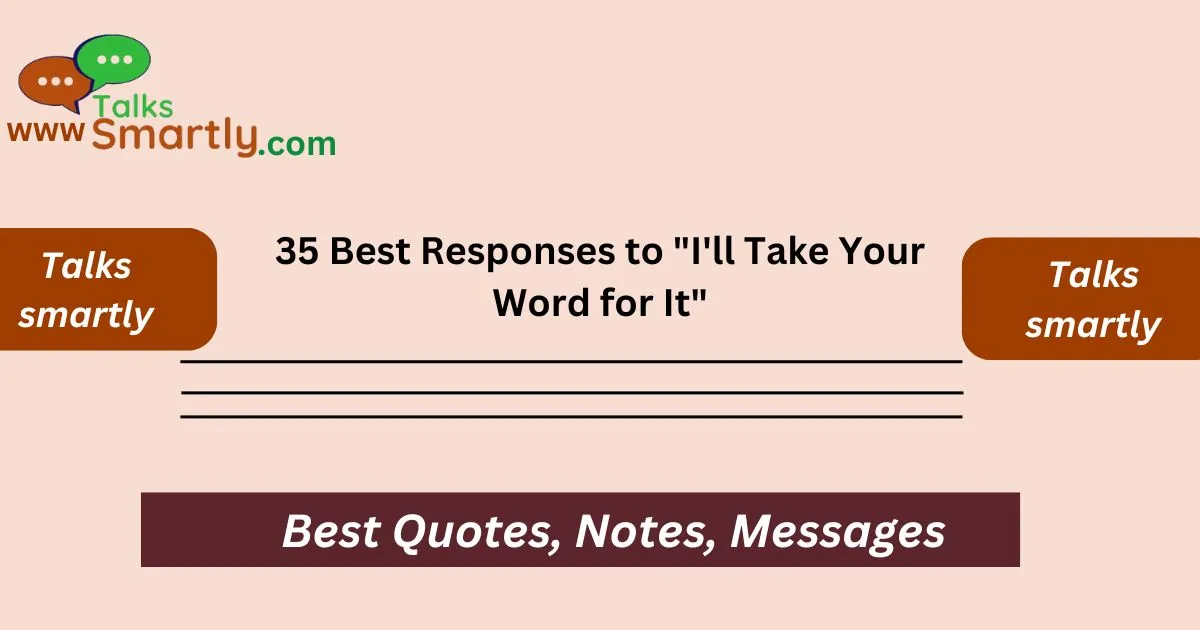“Here are some clever and engaging responses to “I’ll take your word for it.”
In conversations, we often encounter phrases that may seem casual but can carry a range of meanings and implications. One such phrase is “I’ll take your word for it.” This expression often indicates trust, acceptance, or sometimes a subtle hint of skepticism. Understanding how to respond to this phrase can enhance communication, build rapport, and even add a touch of humor to a conversation.
If you find yourself unsure how to react when someone says, “I’ll take your word for it,” you are in the right place. In this blog post, we will explore 35 creative and thoughtful responses that can help you navigate this common phrase. Whether you’re looking to express appreciation, add humor, or even challenge the statement, these responses will serve as a guide for effective communication.
Let’s dive into these responses and empower your conversational skills. Each suggestion is designed to be relatable and adaptable, allowing you to connect with your audience genuinely.
Best Responses to “I’ll Take Your Word for It”
- Express Trust
- Add Humor
- Acknowledge the Trust
- Confirm Your Words
- Invite Further Discussion
- Show Humility
- Light-hearted Banter
- Playful Doubt
- Affirmation
- Genuine Appreciation
- Clarification
- Witty Comeback
- Challenge the Idea
- Encouragement to Explore
- Validate Their Choice
- Express Confidence
- Suggest an Alternative
- Show Interest in Their Perspective
- Humor with a Twist
- Bring in a Personal Anecdote
- Be Playfully Sarcastic
- Reaffirm Your Credibility
- Highlight the Importance of Skepticism
- Use a Quirky Reference
- Transition to a New Topic
- Suggest a Follow-up
- Share a Fun Fact
- Turn it into a Compliment
- Challenge with a Question
- Use a Metaphor
- Invoke a Pop Culture Reference
- Point Out the Implication
- Encourage Exploration
- Agree with a Twist
- Use Gentle Humor
1. Express Trust
Expressing trust can create a positive atmosphere. You might respond with, “I appreciate your trust in me!” This reinforces your credibility and reassures the other person.
Example, if a friend believes your recommendation for a restaurant, saying, “I appreciate your trust in my taste!” can deepen your bond.
2. Add Humor
A touch of humor lightens the conversation. You could say, “Just remember, I’m not a lawyer!” This can make the exchange more enjoyable.
Example, if discussing a movie, you might say, “I’ll take your word for it, but if it’s terrible, I’m blaming you!”
3. Acknowledge the Trust
Recognizing their trust strengthens the relationship. You might say, “Your faith in me means a lot!”
Example, setting, acknowledging, “Your trust gives me the confidence to share more ideas,” can be impactful.
4. Confirm Your Words

Reaffirming your statement can clarify misunderstandings. You could respond, “I stand by what I said!”
Example,if discussing a news article, saying, “I stand by what I said, and here’s why,” can reinforce your position.
5. Invite Further Discussion
Encouraging dialogue can enhance understanding. You might say, “What else would you like to know?”
Example, if discussing travel, you could ask, “What else would you like to know about my experience?”
6. Show Humility
Being humble can foster connection. You could respond with, “I’m just sharing my thoughts!”
Example, in a conversation about a personal achievement, saying, “I’m just sharing my thoughts; I’m still learning,” shows humility.
7. Light-hearted Banter
Engaging in playful banter adds fun to the exchange. You might say, “Just don’t blame me if it’s a flop!”
Example, if recommending a book, saying, “Just don’t blame me if it puts you to sleep!” can keep things light.
8. Playful Doubt
Adding a playful hint of skepticism can spark curiosity. You could respond, “Are you sure that’s wise?”
Example, when discussing a risky investment, saying, “Are you sure that’s wise?” can initiate a deeper conversation.
9. Affirmation
Affirming their decision can encourage trust. You might say, “That’s a solid choice!”
Example,if they’re trying a new restaurant based on your recommendation, you could say, “That’s a solid choice; you’ll love it!”
10. Genuine Appreciation
Expressing appreciation can strengthen connections. You could respond, “Thank you for trusting me!”
Example, project, saying, “Thank you for trusting me with this task,” acknowledges their confidence in you.
11. Clarification
Seeking clarification can clear any confusion. You might say, “What part are you unsure about?”
Example,if discussing a complex topic, asking, “What part are you unsure about?” encourages dialogue.
12. Witty Comeback
A witty comeback can keep things lively. You could say, “That’s the spirit! Keep that faith!”
Example,hearted debate, saying, “That’s the spirit! Keep that faith, or we’ll debate it again!” adds humor.
13. Challenge the Idea

Challenging the idea can encourage deeper thought. You might say, “But what if I’m wrong?”
Example, in a discussion about a controversial topic, saying, “But what if I’m wrong?” invites reflection.
14. Encouragement to Explore
Encouraging exploration can be engaging. You might respond, “Why not check it out yourself?”
Example,a new app, saying, “Why not check it out yourself? It might surprise you!” fosters curiosity.
15. Validate Their Choice
Validating their choice builds trust. You could say, “You have great instincts!”
Example, if they’re considering a new job based on your advice, you might say, “You have great instincts; I know you’ll do well.”
16. Express Confidence
Expressing confidence can be empowering. You might respond, “I believe in my recommendation!”
Example, saying, “I believe in my recommendation; let’s give it a shot,” can inspire confidence in your ideas.
Navigating Inappropriate Comments: Best Responses
17. Suggest an Alternative
Suggesting an alternative can broaden perspectives. You might say, “How about trying something different?”
Example, if discussing dinner plans, saying, “How about trying something different, like sushi?” introduces variety.
18. Show Interest in Their Perspective
Showing interest encourages open dialogue. You could ask, “What do you think about it?”
Example,if discussing a new policy, asking, “What do you think about it? Your opinion matters,” can enhance discussion.
19. Humor with a Twist
Using humor with a twist keeps the conversation lively. You might say, “Just don’t tell anyone I said that!”
Example, a gossip topic, saying, “Just don’t tell anyone I said that; I’ll deny it!” adds humor.
20. Bring in a Personal Anecdote
Sharing an anecdote can make your point relatable. You could say, “That reminds me of a time I…”
Example,sharing a story about a funny encounter can add a personal touch to the conversation.
21. Be Playfully Sarcastic
Playful sarcasm can lighten the mood. You might respond, “Oh sure, because I’m never wrong!”
Example, saying, “Oh sure, because I’m never wrong! Let’s not go there!” adds humor.
22. Reaffirm Your Credibility
Reaffirming your credibility can strengthen your position. You could say, “I’ve done my research!”
Example, in a discussion about health, saying, “I’ve done my research, and this is what I found,” reinforces your credibility.
23. Highlight the Importance of Skepticism
Encouraging skepticism can spark critical thinking. You might say, “Always question things!”
Example, in discussing news, saying, “Always question things; that’s how you learn,” encourages critical thinking.
24. Use a Quirky Reference
A quirky reference can add a fun twist. You could say, “It’s like the plot of a sitcom!”
Example, a complicated situation, saying, “It’s like the plot of a sitcom! You wouldn’t believe it!” keeps it entertaining.
25. Transition to a New Topic
Shifting the conversation can keep it fresh. You might say, “Speaking of which, have you heard about…”
Example,transitioning to a new topic about a recent event can redirect the conversation smoothly.
26. Suggest a Follow-up
Suggesting a follow-up can show commitment. You might say, “Let’s revisit this later!”
Example, discussion, saying, “Let’s revisit this later; I’d love to hear more ideas,” encourages collaboration.
27. Share a Fun Fact
Sharing a fun fact can be engaging. You could say, “Did you know that…”
Example, sharing a fun fact about travel can pique interest, saying, “Did you know that the Eiffel Tower can be 15 cm taller in summer?”
28. Turn it into a Compliment
Turning it into a compliment can strengthen bonds. You might say, “That’s why I value your opinion!”
Example,if discussing a decision, saying, “That’s why I value your opinion; you always know what to say,” builds rapport.
29. Challenge with a Question

Challenging with a question can provoke thought. You could ask, “What led you to that conclusion?”
Example, a belief, asking, “What led you to that conclusion? I’m curious,” encourages discussion.
30. Use a Metaphor
Using a metaphor can illustrate your point creatively. You might say, “It’s like navigating a ship in fog!”
Example,comparing a tricky situation to navigating a ship in fog illustrates complexity.
31. Invoke a Pop Culture Reference
Using a pop culture reference can connect with your audience. You could say, “It’s like an episode of your favorite show!”
Example, a dramatic situation, saying, “It’s like an episode of your favorite show; you won’t believe the twist!” adds relatability.
32. Point Out the Implication
Highlighting the implication can encourage deeper understanding. You might say, “What does that say about our choices?”
Example, discussing a decision, asking, “What does that say about our choices? It’s important to consider,” promotes critical thinking.
33. Encourage Exploration
Encouraging exploration invites engagement. You might say, “Why not dive deeper into this topic?”
Example,a new trend, suggesting, “Why not dive deeper into this topic? There’s so much to learn,” fosters curiosity.
34. Agree with a Twist
Agreeing with a twist can keep it interesting. You could say, “I agree, but only if you try it first!”
Example,a new experience, saying, “I agree, but only if you try it first; I’ll cheer you on!” adds humor.
35. Use Gentle Humor
Gentle humor can ease the conversation. You might say, “I promise I won’t lead you astray!”
Example,when suggesting a new restaurant, saying, “I promise I won’t lead you astray; it’s worth a shot!” keeps it light-hearted.
Answer the key Question
What does “I’ll take your word for it” mean?
This phrase typically indicates that someone trusts your opinion or information without needing further proof.
How should I respond to this phrase?
Your response can vary based on context. You can express appreciation, add humor, or invite further discussion.
Can humor be effective in these responses?
Yes, humor can lighten the conversation and make it more engaging, helping to build rapport.
Is it important to acknowledge trust in communication?
Absolutely! Acknowledging trust strengthens relationships and encourages open dialogue.
What if I disagree with the statement?
You can respectfully challenge the idea by asking questions or providing your perspective while maintaining a friendly tone.
Conclusion
Navigating the phrase “I’ll take your word for it” can be both an opportunity for connection and a moment for humor. With these 35 responses, you can effectively engage in conversations, express appreciation, or even spark further discussion. Remember, effective communication is not just about what you say, but how you say it.
By incorporating these responses, you can enhance your conversational skills and build stronger relationships with those around you. So, the next time someone says, “I’ll take your word for it,” you’ll be ready with a thoughtful and engaging reply.












